C. E. Lipe Machine Shop
| Machine shop | |
| Industry | Machinery, experimental |
| Founded | 1880 |
| Headquarters | Syracuse, New York |
Key people | Charles E. Lipe (1850-1895), Alexander T. Brown |
| Products | Machinery, experimental |
The C. E. Lipe Machine Shop was established in Syracuse, New York in 1880 in the Lynch Building by Charles E. Lipe (1850–1895),[1] a mechanical engineer. The building became an early industrial incubator[2] and was commonly known as the Lipe Shop. While Lipe worked on his own ideas, he rented out facilities to others.[3] Some of the leaders in industry worked both independently and side by side in this building to solve the industrial problems of their era. "These men sowed the germs that sprouted into major business enterprises in Syracuse and elsewhere" and for many years the machine shop was known as the "cradle of Syracuse industries."[4]
History
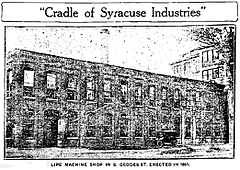
The modest two-storied brick building, known as the Lynch Building, with 20,000 square feet (1,900 m2) of floor space at 208-214 South Geddes Street in Syracuse is known as the "cradle of Syracuse industries,"[3] a phrase coined by Samuel Cook, an executive at the Brown-Lipe-Chapin Company in 1916.[5]
By August 1998, the machine shop had reverted to the home of a nondescript hardware store near the intersection of Geddes and Fayette streets.[2]
Syracuse manufacturing concerns, which by 1921 represented "millions of invested capital" and employed thousands of individuals, had their inception in the building. For many years, the shop's office had been a "veritable museum" of designs, models, parts and pictures of various kinds of machinery developed there, or by the inventors and their associates.[4]
Lynch building
Patrick Lynch, a salt manufacturer, built the structure first known as the Lynch Building in South Geddes Street between Fayette and Marcellus streets in 1861 as a machine shop to serve the salt industry, which relied on pumps, engines and other mechanical devices made in the Syracuse area.[2] Except for the addition of wings, the building remained unchanged for several decades.[3]
After the salt industry began to wane, the building was used for the manufacture of farm implements for a few years. In 1875, the Robinson Plow Company occupied the plant, succeeding an earlier manufacturer of lawn mowers there. In 1876,[6] the company went on to become the Syracuse Chilled Plow Company.[3] By 1879, the Lynch Building was put up for sale.[2]
Lipe shop
The building became an industrial incubator after Charles E. Lipe, 29, a young Cornell University engineering graduate of the Sibley College of Mechanics[7] in 1873[8] and son of a German-born farmer from Fort Plain, Montgomery County, New York, moved into the building in 1880 and set up the C. E. Lipe Machine Shop.[2] The building was commonly known as the Lipe Shop.[3]

While Lipe worked on his own ideas, he rented out facilities to others. Next door, his old engineering professor from college, John E. Sweet, moved in and used the space to build steam engines. Sweet leased half the space in the building for many years.[3] In 1892, Sweet moved into a new factory next door and the Straight Line Engine Company "remained a west side fixture" until the factory closed in 1961. It was replaced several years later by the Geddes Street Plaza.[7]
The Lipe Shop was a "haven for inventors and an incubator of industries" and Lipe himself was a prolific inventor. He had invented a cigar-rolling machine, a broom making machine, motion picture equipment, automatic looms and time recorders.[10]
Business leaders
Lipe formed associations with early business leaders, all in different fields, including; Alexander T. Brown, author of more than 150 patents for creations ranging from typewriters to automobile transmissions,[2] Herbert H. Franklin, John R. Montague, Albert Seymour, H. Winifield Chapin, Lyman C. Smith, Hurlburt W. Smith, Wilbert Smith, John Wilkinson, James Pass,[11] and Herbert Leighton.[7]
Motion picture camera
Herman Casler, a native of Fort Plain, New York, was employed as a draughtsman for Lipe[12] and began working in the Lipe shop as a 22-year-old apprentice in 1889.[7] The two men were cousins.[10] In 1894, at age 27, Casler invented the mutoscope, a peephole machine in which a viewer could watch a movie by turning a crank handle. In 1895, he invented the biograph camera, one of the world's first motion picture cameras and at the time, the best on the market. The first camera weighed more than 500 pounds.[7]
Casler teamed up with Harry Marvin of the Marvin Electric Rock Drill Company who invented an electric rock drill in the machine shop that was used at Split Rock Quarry in the Town of Onondaga, New York and elsewhere. Marvin, Casler, Elias Koopman, a New York City "novelty purveyor," and William Kennedy Laurie Dickson, a former associate of Thomas A. Edison, formed the American Mutoscope and Biograph Company in 1896 and moved the business to Canastota, New York.[2] Casler and Edison were the originators of motion pictures in the United States. Edison obtained a patent for his own movie camera in 1897. He sued Biograph in 1898 for patent infringement; however, lost the suit after years of legal battles. In 1908, a year after the courts upheld Biograph's camera patent, the establishment joined with Edison's company to form the Motion Picture Patents Company.[7]
Not only did Casler perfect the first mutoscope at the Lipe shop, the machine was manufactured there until 1905.[12]
Industries
After 1880, on the second floor of the Lipe Shop, Robert Love worked on a new fertilizer spreader. The horse drawn manure[13] spreader was produced later by the Kemp & Burpee Manufacturing Company (founded 1878),[14] which maintained a large plant in Syracuse until they were bought out by John Deere Company of Moline, Illinois.[15] During 1904, they advertised their "Success Manure Spreader and Fertilizer Distributer" in a national trade journal.[14]
On that same floor, the first Franklin automobile was manufactured. Herbert H. Franklin had gone to the shop to manufacture his die castings at H. H. Franklin Manufacturing Company and while there, met John Wilkinson, who was working on an experimental motor car in the same place.[12]
One of the world's first coffee hulling machines was manufactured in the building by Engelberg Huller Company, as well as many other innovations were invented there such as electrical supplies, building materials, tire chains and a time clock manufactured by Bundy Recording Company.[2]
During 1894, the Montague Roller Cotton Gin Company was manufacturing cotton gins in the building at 208 South Geddes Street. That same year, Marvin Electric Drill Company was also in operation in the manufacture of twist drills.[16]
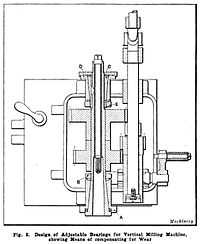
Globe Malleable Iron and Steel Company were founded in 1910 and was an "indirect product" of the machine shop. By late 1922, the company was expanding their Greenway Avenue plant and were planning on hiring 1,200 workers.[17]
The machine shop was the incubus for the early typewriter industry in Syracuse. Some of the young engineers who came out of that enterprise included Alexander T. Brown and brothers Lyman C. Smith, Hurlburt W. Smith and Wilbert Smith who were local industrialists[18] and established Smith Premier Typewriter Works and L. C. Smith & Bros. Typewriter Company, founded by Lyman C. Smith and later known as Smith-Corona.[6]
Lipe innovations
One of the first products to be manufactured in the Lipe Shop in 1880 was a handheld corn planter that Charles Lipe had invented as a teenager. The spring-loaded device held kernels that were injected as the operator "stabbed the end of the soil."[2]
He teamed with Walrath in 1880 to form Lipe-Walrath Company[12] and invented a broom-sewing machine and by 1885 invented a cigar-box making machine.[2]
Patents
During April 1890, Lipe obtained a patent with John Lighton for a "coin controlled test lifting machine."[19]
Lipe was granted U.S. Patent 512,304 on January 9, 1894, for a hulling machine described as "improvements to patent 424,602 from Engelberg Huller Company. Patent 525,813 was granted on September 11, 1894, for a hulling and cleaning machine which was "intended for hulling, cleaning and separating coffee berries."[20]
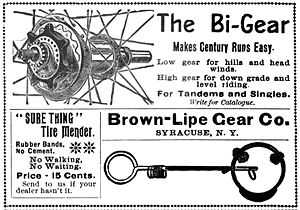
This milling machine was considered "novel" because it had an "arm sliding in the head." The patent was purchased by the Brown & Sharpe Manufacturing Company.[21]
Brown-Lipe gears
The gear industry in Syracuse got its start in the Lipe shop[4] in 1894 when together with Alexander T. Brown, the two engineers invented their two-speed Hy-Lo Bi-Gear for bicycles. In 1895, the men established the Brown-Lipe Gear Company, and although the bicycle gear failed to catch on during the days of the two-wheelers, it soon found a lucrative market in the automobile industry. In January 1904, the Brown-Lipe Gear Company moved to the former offices occupied by the Franklin Automobile Company. According to manager, H. W. Chapin, the factory had been running nights to keep up with demand and "gears and transmissions made by this concern are being used by a large number of manufacturers."[22]
Lipe's brother, Willard C. Lipe (1861–1929),[5] stepped up after his brother died in 1895[23] and the company began making three-speed transmissions. Among his first customers were H. H. Franklin Manufacturing Company, Yellow Cab Company and Henry Ford. By 1906, the company moved into a new five-story factory at the corner of West Fayette and South Geddes streets.[2] It is reported that Henry Ford visited the Lipe Shop to oversee the construction of parts for his first automobile,[24] the Model T.[5]
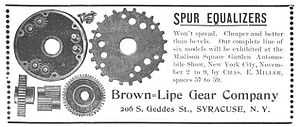
Brown-Lipe-Chapin differentials and transmissions
In 1910, Alexander T. Brown, Willard Lipe and Winifield Chapin established Brown-Lipe-Chapin to build automobile differentials, transmission gears and clutches. The new company built a five-story factory at the corner of West Fayette and Seneca streets and employed close to 5,000 workers.[2] The company was sold to General Motors in 1923[5] and later became the Inland Fisher Guide unit of General Motors, which employed more than 1,300 people in Salina until the company closed that plant in 1993.[25] The firm later came under the control of the Spicer Manufacturing Company of Toledo, Ohio and moved its plants out of Syracuse.[2]
Lipe-Rollway ball bearings
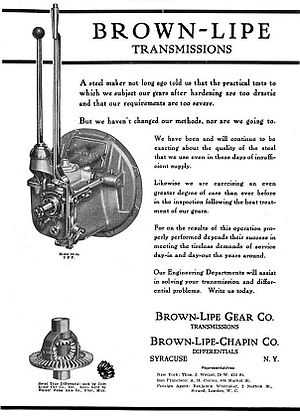
The Rollway Bearing Company was founded in 1895[6] as Department of the Railway Roller Bearing Company. The firm expanded through the early part of the 20th century and was incorporated in 1908 as the Roller Bearing Company and expanded steadily during World War I, producing general-purpose roller bearings for heavy duty equipment used in steel, pulp and paper mills.[26]
The Brown-Lipe Gear Company "re-emerged" again in 1917 under the management of Arthur E. Parsons. During 1942, the firm merged with the Rollway Bearing Company, creating the Lipe-Rollway Corp. who continued in business until 2002[5] when they became a division and key brand of Emerson Power Transmission, still in business today.[26] At that time, the company employed 195 workers in the Syracuse area.[5]
C. E. Lipe estate
After Charles E. Lipe died in 1895, a large portion of the shop was maintained by the C. E. Lipe Estate, for the manufacture of special machinery and general machine work of the higher grades. It was the "best equipped machine shop in Central New York, having machinery and tools adapted to the widest range of work."[23]
Lipe's brother, Willard C. Lipe was manager of the plant and estate.[23] By 1921, the shop was still in the business of "building special machinery" and performing experimental work. The building became a laboratory for hundreds of mechanical experiments, some of which failed "while others succeeded even beyond the wildest dreams of the projectors."[4]
Recent years
The building is still in use today as a hardware store.[7]
External links
- Industrial Age Fed Syracuse Boom, Tim Knauss, Syracuse Then and Now, 2010
- Central Upstate's History of Innovation & Creativity - New York's Creative Core, 2010
- Rollway Bearing History, 2011
- Lipe Machine Shop - Wikimapia, 2011
- Who's Who of Victorian Cinema - Henry Norton ('Harry') Marvin, 2011
References
- ↑ The Magazine of the New York State Museum. New York State Museum, Sept. 2005. Retrieved August 2, 2011.
- ↑ 2.0 2.1 2.2 2.3 2.4 2.5 2.6 2.7 2.8 2.9 2.10 2.11 2.12 "Inventors hatched industries in S. Geddes Street building". Syracuse Herald Journal (Syracuse, New York). August 4, 1998.
- ↑ 3.0 3.1 3.2 3.3 3.4 3.5 "Inventions Built Industries Here". Syracuse Journal (Syracuse, New York). March 20, 1939.
- ↑ 4.0 4.1 4.2 4.3 "Cradle of Syracuse Industries". Syracuse Journal (Syracuse, New York). July 23, 1921.
- ↑ 5.0 5.1 5.2 5.3 5.4 5.5 "New Business for Old Family". Syracuse Post-Standard (Syracuse, New York). April 24, 2005.
- ↑ 6.0 6.1 6.2 Hillenbrand, Dick. "A List of Syracuse Businesses from an 1948 Syracuse Centennial Dinner Program". Ancestry.com, March 4, 1999. Retrieved July 28, 2011.
- ↑ 7.0 7.1 7.2 7.3 7.4 7.5 7.6 Sean Kirst (July 24, 2008). "Vacation thoughts VII: Hardware throwback". Syracuse Post-Standard (Syracuse, New York).
- ↑ The ten-year book of Cornell university, Volume 4. Ithaca; Cornell University, 1908. Retrieved August 3, 2011.
- ↑ Arnold, Horace L. "Modern Machine-Shop Economics. Part II" in Engineering Magazine 11. 1896
- ↑ 10.0 10.1 Franklin H. Chase. Syracuse and Its Environs. New York; Chicago: Lewis Historical Pub. Co., 1924.
- ↑ "Syracuse to Share Auto Prosperity". Syracuse Herald (Syracuse, New York). January 13, 1928.
- ↑ 12.0 12.1 12.2 12.3 "Shop Erected in 1861, "Cradle of Industries"". The Post-Standard (Syracuse, New York). May 20, 1916.
- ↑ "Industrial Age Fed Syracuse Boom". Syracuse Herald Journal (Syracuse, New York). August 20, 1999.
- ↑ 14.0 14.1 Dun's Review. R. G. Dun & Company, New York, New York, March, 1904 p. 537. Retrieved July 2, 2011.
- ↑ "Inventions Built Industries Here". Syracuse Journal (Syracuse, New York). March 20, 1939.
- ↑ Boyd's Syracuse Boyd's City Directory 1894. Andrew Boyd, 1894.
- ↑ "Globe Malleable to Use 1,200 Men on New Orders". Syracuse Herald (Syracuse, New York). December 31, 1922.
- ↑ Automotive Industries, Volume 26. The Automobile Weekly, The Class Journal Company, New York. N.Y., June, 1912. Retrieved 2010-07-18.
- ↑ "The Herald's Patent List". The Evening Herald (Syracuse, New York). April 23, 1890.
- ↑ "Engelberg, Inc.". Vintage Machinery, 2011. Retrieved August 3, 2011.
- ↑ Supports for Milling Machine Arbors. Machinery, Volume 24, The Industrial Press - August 1918. Retrieved August 3, 2011.
- ↑ Motor age, Volume 5, No. 23. The Trade Press Co., Chicago, Illinois - January, 1904. Retrieved January 2, 2011.
- ↑ 23.0 23.1 23.2 "The New York Industrial Recorder". The Post-Standard (Syracuse, New York). January 1, 1898.
- ↑ Evamaria Hardin and Jon Crispin. Syracuse Landmarks: An Aia Guide to Downtown and Historic Neighborhoods. Central New York Chapter of the American Institute of Architects, 1993. Retrieved July 30, 2011.
- ↑ "Industrial Age Fed Syracuse Boom". Syracuse Then and Now, 2010. Retrieved 2010-07-29.
- ↑ 26.0 26.1 "Rollway Bearing History - Taking the First Steps". Emerson Industrial Automation - Rollway, 2011. Retrieved July 31, 2011.